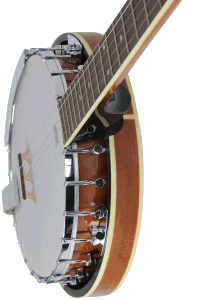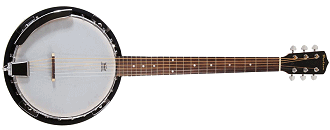I don’t need a travel guitar to sit around campfires or to take white water rafting, only to keep in practice when I’m away from home. I have recently adopted a reworked cheap 6-string banjo as my current “travel guitar,” because – in spite of drawbacks that include a Harmony-style half-circle neck, it plays more like a guitar than the commercially available travel guitars.
That wasn’t my plan at the first. To put things in perspective, in addition to owning more guitars than I need, I already own two six-string banjos and have owned two others, mostly “better” instruments than this one. I also own one “travel guitar” (a Martin Backpacker) and have tried several others.
The instrument discussed in this article is actually a “rescue banjo” that started out as a “lefty.” I saw it languishing, unappreciated, abused, and underfed, in the unexplored back aisle of a local pawn shop that specializes in handguns and stolen power tools.
Some people can’t resist puppies in cages; I have trouble resisting even a cheapo banjo that could be making music but isn’t. Their sad puppy-dog eyes get to me every time. That doesn’t mean I buy them all, but I’ve taken home more than one.

I didn’t realize that the “Davison” was made by Jameson or I wouldn’t have bothered, having tried Jameson instruments in the past and been less than impressed. I was a little put off by the caramel color – I do a certain amount of historical recreations, and this was not quite “right.” Still, my plan from the start was to use it backless, in which case the odd color would be less obvious.
The banjo had a decent neck – the most important part of any banjo. I didn’t think it would be hard to convert from a “lefty” to a “righty” (something that’s close to impossible on a 5-string banjo). That would involve moving the arm-rest around and replacing the bridge and nut. The photo below shows a new 6-string version with the resonator still attached, for your reference.
 I couldn’t get either the bridge or the nut from Jameson, so I ordered the bridge online from a Chinese vendor (through Amazon here). Mistrusting the measurements of the nuts I could order online, I got a nut “blank” from my local guitar store (Guitar Attention Center, in Springfield OH). There I could check the dimensions against the old nut and be certain I was buying something close.
I couldn’t get either the bridge or the nut from Jameson, so I ordered the bridge online from a Chinese vendor (through Amazon here). Mistrusting the measurements of the nuts I could order online, I got a nut “blank” from my local guitar store (Guitar Attention Center, in Springfield OH). There I could check the dimensions against the old nut and be certain I was buying something close.
Here’s an irony; if I’d started with a right-handed instrument or been able to get the nut from Jameson, I wouldn’t have been forced to put so much time into getting it “right,” and probably wouldn’t be as pleased with it as I am now.
First Steps
Initially, I was thinking of using this as a “beach 6-string banjo” I could take to the beach along with my 5-string beach banjo (currently a Deering Goodtime). I was definitely going to use it backless from the start. Since I needed to take the resonator off to tighten the head anyway, that was more or less my first step.
I also took off the little brackets that hold the resonator on, a sign of cheap banjos, by the way. I stored the resonator and its hardware away safely, moved the arm rest around to its “right hand” position and started tightening the head.
Once I had the bridge and nut I needed, I cut shallow slots in the nut where they would need to be, then put the new nut and bridge on the banjo, along with new silver-colored guitar strings.
Micro-Adjustment With Mid-Century Tools
Then I did a preliminary setup, making sure the head was tight enough and the coordinator and neck adjustment rods were optimum. Then, I used a very fine file and an auto feeler gauge to file the nut slots down to JUST higher than the first fret. This resulted in very good action, considering the original cost of the banjo.
Testing, Testing
Once it was more musical instrument than wall decoration, I put it through its paces. It has a half-circle neck like the old Harmonies, but at least it feels like a guitar, unlike the neck on the Backpacker (sorry, BP lovers, but it feels like a Cricket bat to me). Also, my “real” guitars have scale lengths between 25.5″ and 28.5″, so the Davison’s 26.5″ scale length is more like my real guitars than my Backpacker’s 24″.
On a recent trip to the ocean, I took the Davison and my old Goodtime so I could switch off between 5 and 6-string to keep in practice on both. To my surprise, I enjoyed playing the six-string Davison nearly as much as I enjoy playing my 5-string Goodtime, and that’s a great deal.
Buyer Beware
The caveat, of course, is that when you order one of these, you have a very good chance of getting one that is not set up at all, and either spending hours setting it up, or spending $75 to $100 to get someone else to set it up.
I think of even the best Chinese banjos as “banjo kits” that someone else has mostly put together for you. My article “Setting up Six String Banjos” will get you started on making them playable.
On this one I went the “extra mile,” and got an instrument that is actually a delight to play, and which helps me keep up my “guitar chops” where it’s not practical or safe to take an actual guitar.
Easy Schlepping
BTW, I’m using it with a “Superior C-267” gig bag made for backless banjos, since it has the resonator off. Without the resonator, the banjo weighs about 6 pounds, which is still more than the Goodtime’s 4 pounds, but much better than my resonator 6-strings.
Even in their bags, both banjos together barely weigh 12 pounds. If I could get a single gig bag that would hold them both, I could backpack them anywhere without exactly straining myself.
Nobody makes those. But at least when I’m going on a trip that doesn’t involve flying, I don’t have to decide whether to go without practicing guitar for a week or without practicing banjo for a week. And when some twit tells me I’m not a “real” banjo player because my banjo has six strings, I’ll just hand him the six string, get out the five string, and challenge him to keep up. 🙂
Identity Bereft
Here’s an interesting last touch. While I was working on this banjo, long before I was satisfied with its action or even sure it was a “keeper,” I took it “out” a few places. As a precaution against people thinking I was putting my approval on a banjo I wasn’t even sure about yet, I put black electrical tape over the word “Davison” on the headstock. It completely blended in and kept me from accidentally seeming to promote a product I wasn’t entirely sure about yet. (In fact, even my overall good report is full of caveats today, but I was even less sure a few weeks ago.)
When I peeled the electrical tape off last week, part of the word “Davison” had disappeared, without any damage to the finish of the banjo. Apparently the name was stamped or stenciled on after the varnish on the head had dried, an interesting approach, which makes me wonder what other brand names have been stamped on the same instrument.
Losing part of the name “Davison” did not upset me as much as if, say, the name Deering, Taylor, Gibson, or Fender had come off one of my instruments. I may dig out the tape again and continue the process. After all, it’s hardly the banjo I started with. . . .
Keep in Touch!
Please contact us if you have any questions, concerns, additions, or corrections to the content of this blog or anything else you see on our site. Or if you’d like to sign up for our Momma Don’t Low newsletter, which reports on Paul’s activities, blogs, and new articles, as well as topics of more general interest related to acoustic and traditional music and musical instruments, including traditional “folk” instruments and vintage saxophones.
And keep making music that makes people either happy or responsible, or, hopefully both.
Paul Race






By the way, as guarded as I’ve been about my recommendation of the Davison 6-string banjo, I must add a note that the instrument is often promoted as a “banjo guitar.” There is no such thing as a “banjo guitar.” Neither is there any such thing as a “banjitar” or a “gitjo” or any of the other clever names that people have given 6-string banjos to imply that they’re somehow “really” guitars. 6-string banjos have been around for a century in many tunings and configurations, as have 4-string banjos. Nobody claims that a 4-string jazz banjo, which uses the same tuning as a viola is “really” a viola. Or that a 4-string Celtic banjo, which uses the same tuning as an octave mandolin is “really” a mandolin. Or that the 4-string banjo players who tune their banjos like the highest four strings of a guitar (“Chicago tuning”), are “really” playing guitars.
It IS a shame that so many low-end manufacturers of 6-string banjos have made so many false claims that anyone who can play three chords on a guitar can sound like Earl Scruggs on a 6-string banjo. The truth is NOBODY with a 6-string banjo sounds like Earl Scruggs – there isn’t a “drone string.” But the fact that the importers of cheap Asian 6-string banjos, many of which are far worse than the Davison, make so many false and patronizing advertising claims does not invalidate the 6-string banjo’s century-old legitimacy as a banjo in its own right.
For more information on the 6-string banjo’s history, please check out our article “Are 6-String Banjos for Real?”
In case you wondered.
I also recently bought a Jameson 6 string banjo at a pawn shop, it was nicely set up and I am really enjoying it, Cost was $139.
Mike, thanks for sharing. You’re lucky it was set up already. Usually even “legitimate” music stores don’t bother. What styles do you play on it?
Hi Paul,
I have researched the 6 string banjos and I think it is down to a Jameson or Deans Backwoods.I will be sorting this out when Covid 19 is finally over so that I can get back to playing again.Hope you are keeping well.
Regards,
Joe Dunn.
Joe, thanks for staying in touch. If you can get a Dean Backwoods 6 for a reasonable price, it is a better banjo than the Jameson. It WILL need set up. My first 6-string banjo was a Dean Backwoods six that I got from a Country guitar player cheap because the music store he bought it from hadn’t bothered to set it up and he thought he just wasn’t cut out to play the thing. I tightened the head, adjusted the neck, and replaced the strings and used it happily until it was time to upgrade. The non-electric one is actually better built than the electric one, by the way.
Let me know how things work out!